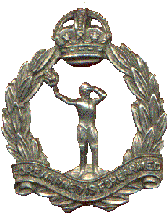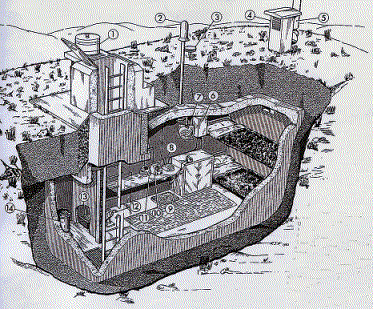

|
Most people knew that radar was used to guide RAF Spitfires and Hurricanes to their targets in the Battle of Britain, but only a few will recall that there was another method of spotting and identifying aircraft. Members of the mainly voluntary Observer Corps were on duty day and night, watching and listening in all weathers to identify and report the location of aircraft. During 1941, they were to gain the distinction of becoming the Royal Observer Corps. This was a remarkable recognition for a voluntary organisation, whose first operational Groups of Observer Posts were first formed in 1925.
During the First World War, the collection of information about hostile aircraft and its distribution was the responsibility of an elaborate system of observer posts, and this system had been retained after the in a small area as an 'Observer Corps', composed of volunteers enrolled as special constables. In its first report in 1925, the ARP committee recommended extending the system further, and recommended setting up of a further system of observation posts under police control. By the autumn of 1932, the most active development of the warning system related to the collection of information, which, after 1929, came under the control of to the Air Ministry. By 1935, in the areas considered to be within range of hostile aircraft, By 1935, the Observer Corps, in those areas considered to be within range of hostile aircraft, namely on southern and eastern English coasts, and the counties bordering London the observation system, manned by volunteers of the Observer Corps, was ready to go operational at any time. The system expanded in July 1937 to cover virtually all England, Wales and Eastern Scotland. On the 26 September 1938, following the Munich Crisis, the Observer Corps and the anti-aircraft units of the Territorial Army went on alert, and the warning system for eastern parts of the country placed on a state of increased readiness. Once the crisis had subsided, further improvements took place to improve the telephone and other technical facilities. Ten days before war finally broke out; all units went on a state of advanced readiness. All sightings of all approaching enemy aircraft, first by radar as they approached the chain of radar stations monitoring aircraft out to sea, and then the Observer Corps once the aircraft were over land, would be passed to Fighter Command to determine the appropriate course of action. In Witheridge, Jack Knight, along with Reg Rodd, were the first to join the Royal Observer Corps. Their headquarters, ("after it had been deloused") being in Reg Rodd's chicken house, next to Merryside, before a proper shed was constructed. It was manned 24 hours a day, and full timers worked 80 hours a week (4 hours on, eight off, four on, 12 off), and were paid £2.16.0. Names that (JK) recalls as being members included Fred and Sid Radford, Sid Dart, Frank Kingdom, Bill "Postman" Kingdom, Bill "Sideways" Kingdom, Bill Gold, and Cyril Partridge.
By 1953 the post was at Three Hammers (s.767 114). Support faded away, but by 1959 the state of the Cold War was such that the threat of enemy aircraft had extended to the threat of nuclear war. As a result of ROC promotion, the Witheridge team was re-established, with Bob and Fred Woollacott, John Usmar, Bill Stacey and Ken Williams to man the newly constructed underground post. This was of concrete, with six feet of earth above it to ground level. It contained three bunk beds, a chemical toilet, ration packs for a fortnight. for the nuclear threat there was a radio-active fallout survey meter, and a pin-hole camera. But the aircraft spotting role was still in operation. there was landline communication, and the early members improved the lighting by installing a wind-powered generator. A hand-powered warning siren was provided. R.A.F. uniforms were used - shoes, socks, trousers, jackets, shirts, ties, and raincoats. By 1960 John Usmar was Chief Observer and Fred Woollacott was Leading Observer. Aircraft still mattered, and on one occasion the R.A.F. sent three Argosies at almost ground level to test the post out. They also used to put on a show at Chivenor for the ROC., with free flights. There were annual exams, with aircraft recognition in the Odeon, Exeter, and written exams in University premises. As time went on more and more emphasis was laid on fall-out, how it could be spotted and the public warned. Soon these exams were dominated by nuclear issues. Training exercises were sharpened up by the use of a machine capable of simulating fallout. Training meetings were held fortnightly, usually at the post, but at times in winter at pubs in Chawleigh or Thelbridge. Among the members in the early days were Frank Wheaton (Eggesford), Ron Harvey (Nymet Rowland), John Alleyne (Rose Ash), and from Witheridge Bill Stacey, Sue Haynes, Valerie Hunt and Geoff Lee Cann. Fred Woollacott and Bill Stacey served for 32 years and were each awarded the Long Service Badge with Bar. The post closed in the early 1990s and has been filled in and vanished. but the County H.Q. buildings are in 2004 still visible at Poltimore House, near Exeter. Previous Last Edited 03/07/2006 Copyright © 2000-2006 Witheridge Unless otherwise indicated on the page in question, the photographic images reproduced on this site belong to the Witheridge Archives, and, as such may not be reproduced for commercial purposes without written permission. However, you are welcome to use any of the photographs belonging to the archive for personal and/or non-commercial use. Any material shown as not being owned by the archive may not be reproduced in any form without first receiving written permission from the owner of the material in question. The illustration of the bunker was kindly supplied by F. Woollacott |



